Research Proposal: Social Media and Brand Loyalty in E-commerce
VerifiedAdded on 2023/04/21
|34
|10329
|481
Project
AI Summary
This research proposal, submitted by a student, investigates the impact of social media on the brand loyalty of e-commerce businesses, specifically using Souq in the UAE as a case study. It begins with an introduction outlining the significance of social media's influence on brand loyalty and the objectives of the study, which include examining the relationship between social media marketing and brand loyalty, electronic word of mouth, and consumer purchase intention. The proposal includes a detailed literature review covering social media's role in marketing, brand communities, brand trust, and loyalty. The methodology section outlines the research philosophy, approach, and instruments, including data collection methods, sampling, and ethical considerations. The proposal also provides a project schedule and references. The study aims to fill a gap in existing literature by analyzing the influence of social media on brand loyalty and identifying effective marketing strategies. The research will employ a survey of 50 respondents to gather data and the findings will be analyzed in the context of the literature review.
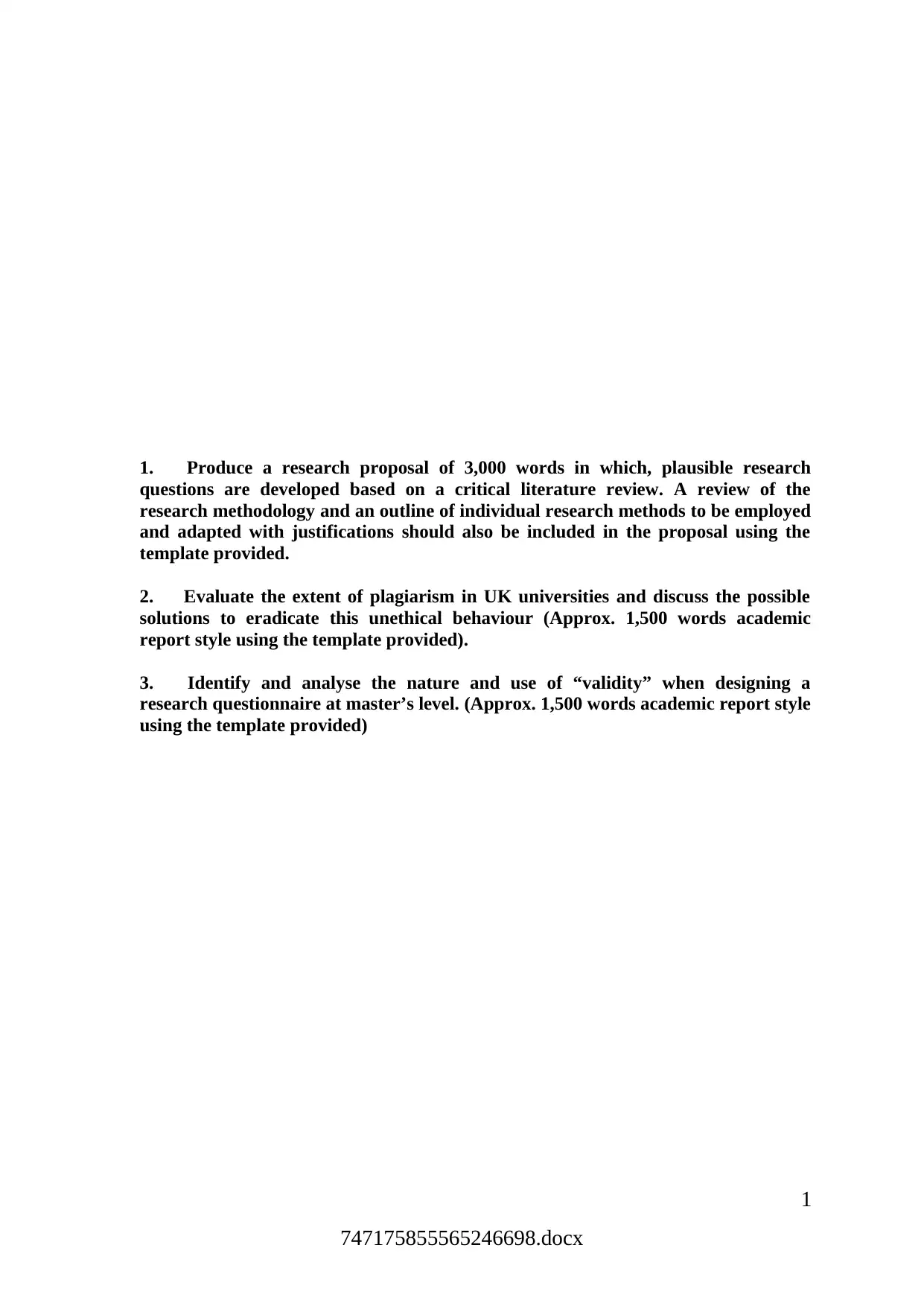
1. Produce a research proposal of 3,000 words in which, plausible research
questions are developed based on a critical literature review. A review of the
research methodology and an outline of individual research methods to be employed
and adapted with justifications should also be included in the proposal using the
template provided.
2. Evaluate the extent of plagiarism in UK universities and discuss the possible
solutions to eradicate this unethical behaviour (Approx. 1,500 words academic
report style using the template provided).
3. Identify and analyse the nature and use of “validity” when designing a
research questionnaire at master’s level. (Approx. 1,500 words academic report style
using the template provided)
747175855565246698.docx
1
questions are developed based on a critical literature review. A review of the
research methodology and an outline of individual research methods to be employed
and adapted with justifications should also be included in the proposal using the
template provided.
2. Evaluate the extent of plagiarism in UK universities and discuss the possible
solutions to eradicate this unethical behaviour (Approx. 1,500 words academic
report style using the template provided).
3. Identify and analyse the nature and use of “validity” when designing a
research questionnaire at master’s level. (Approx. 1,500 words academic report style
using the template provided)
747175855565246698.docx
1
Paraphrase This Document
Need a fresh take? Get an instant paraphrase of this document with our AI Paraphraser

747175855565246698.docx
2
2

1. Produce a research proposal of 3,000 words in which, plausible research questions
are developed based on a critical literature review. A review of the research
methodology and an outline of individual research methods to be employed and adapted
with justifications should also be included in the proposal using the template provided.
---------------------------------------------------------------------------------------------
RESEARCH PROPOSAL
Student Name : Pravin Mathew
Student ID : 1820430
Provisional Topic Title : The impact of social media on brand loyalty of E-commerce
business- A case study of Souq, UAE
Proposal structurally approved by workshop tutor: Yes
747175855565246698.docx
3
are developed based on a critical literature review. A review of the research
methodology and an outline of individual research methods to be employed and adapted
with justifications should also be included in the proposal using the template provided.
---------------------------------------------------------------------------------------------
RESEARCH PROPOSAL
Student Name : Pravin Mathew
Student ID : 1820430
Provisional Topic Title : The impact of social media on brand loyalty of E-commerce
business- A case study of Souq, UAE
Proposal structurally approved by workshop tutor: Yes
747175855565246698.docx
3
⊘ This is a preview!⊘
Do you want full access?
Subscribe today to unlock all pages.

Trusted by 1+ million students worldwide
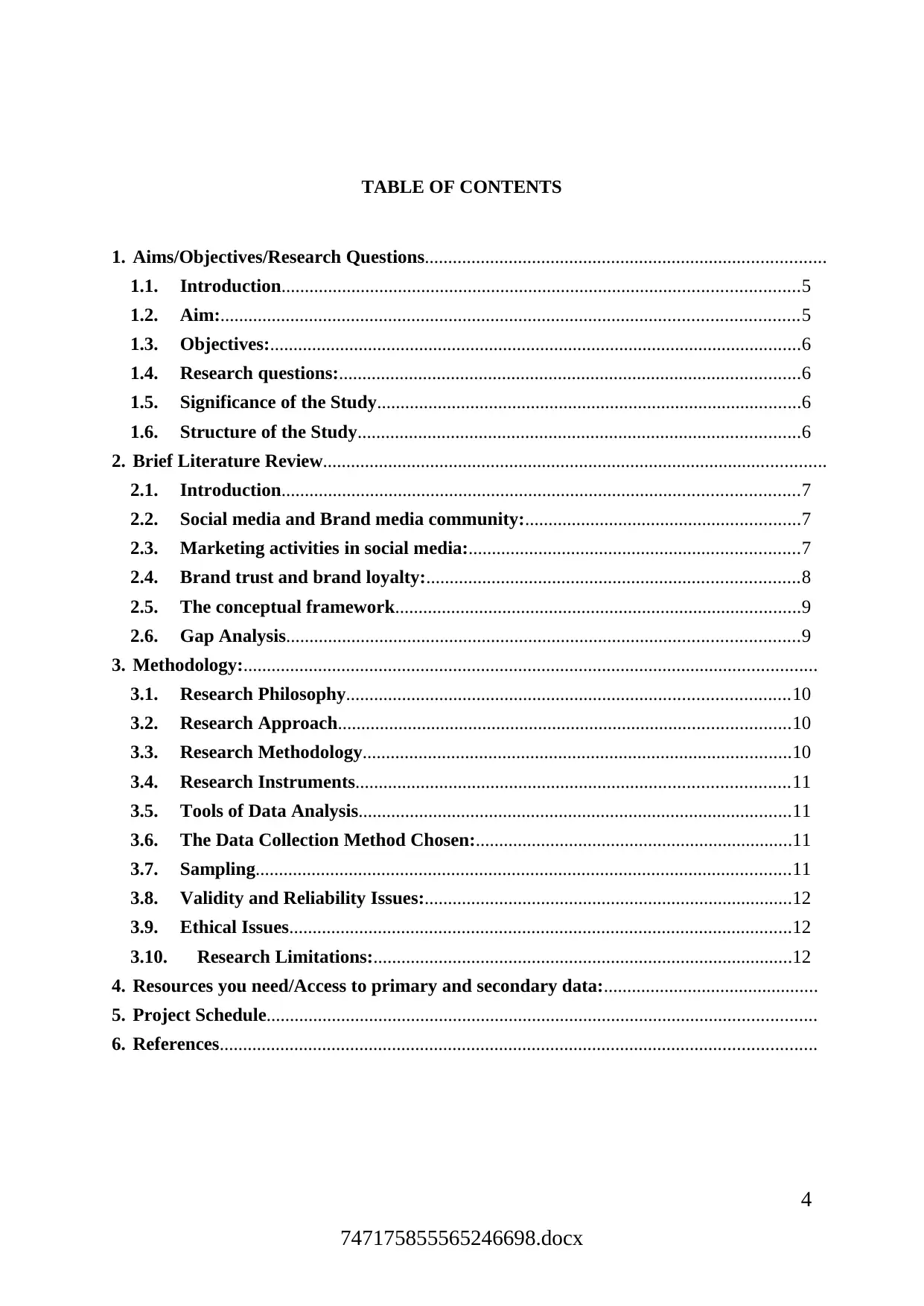
TABLE OF CONTENTS
1. Aims/Objectives/Research Questions......................................................................................
1.1. Introduction...............................................................................................................5
1.2. Aim:............................................................................................................................5
1.3. Objectives:..................................................................................................................6
1.4. Research questions:...................................................................................................6
1.5. Significance of the Study...........................................................................................6
1.6. Structure of the Study...............................................................................................6
2. Brief Literature Review............................................................................................................
2.1. Introduction...............................................................................................................7
2.2. Social media and Brand media community:...........................................................7
2.3. Marketing activities in social media:.......................................................................7
2.4. Brand trust and brand loyalty:................................................................................8
2.5. The conceptual framework.......................................................................................9
2.6. Gap Analysis..............................................................................................................9
3. Methodology:...........................................................................................................................
3.1. Research Philosophy...............................................................................................10
3.2. Research Approach.................................................................................................10
3.3. Research Methodology............................................................................................10
3.4. Research Instruments.............................................................................................11
3.5. Tools of Data Analysis.............................................................................................11
3.6. The Data Collection Method Chosen:....................................................................11
3.7. Sampling...................................................................................................................11
3.8. Validity and Reliability Issues:...............................................................................12
3.9. Ethical Issues............................................................................................................12
3.10. Research Limitations:..........................................................................................12
4. Resources you need/Access to primary and secondary data:..............................................
5. Project Schedule......................................................................................................................
6. References................................................................................................................................
747175855565246698.docx
4
1. Aims/Objectives/Research Questions......................................................................................
1.1. Introduction...............................................................................................................5
1.2. Aim:............................................................................................................................5
1.3. Objectives:..................................................................................................................6
1.4. Research questions:...................................................................................................6
1.5. Significance of the Study...........................................................................................6
1.6. Structure of the Study...............................................................................................6
2. Brief Literature Review............................................................................................................
2.1. Introduction...............................................................................................................7
2.2. Social media and Brand media community:...........................................................7
2.3. Marketing activities in social media:.......................................................................7
2.4. Brand trust and brand loyalty:................................................................................8
2.5. The conceptual framework.......................................................................................9
2.6. Gap Analysis..............................................................................................................9
3. Methodology:...........................................................................................................................
3.1. Research Philosophy...............................................................................................10
3.2. Research Approach.................................................................................................10
3.3. Research Methodology............................................................................................10
3.4. Research Instruments.............................................................................................11
3.5. Tools of Data Analysis.............................................................................................11
3.6. The Data Collection Method Chosen:....................................................................11
3.7. Sampling...................................................................................................................11
3.8. Validity and Reliability Issues:...............................................................................12
3.9. Ethical Issues............................................................................................................12
3.10. Research Limitations:..........................................................................................12
4. Resources you need/Access to primary and secondary data:..............................................
5. Project Schedule......................................................................................................................
6. References................................................................................................................................
747175855565246698.docx
4
Paraphrase This Document
Need a fresh take? Get an instant paraphrase of this document with our AI Paraphraser
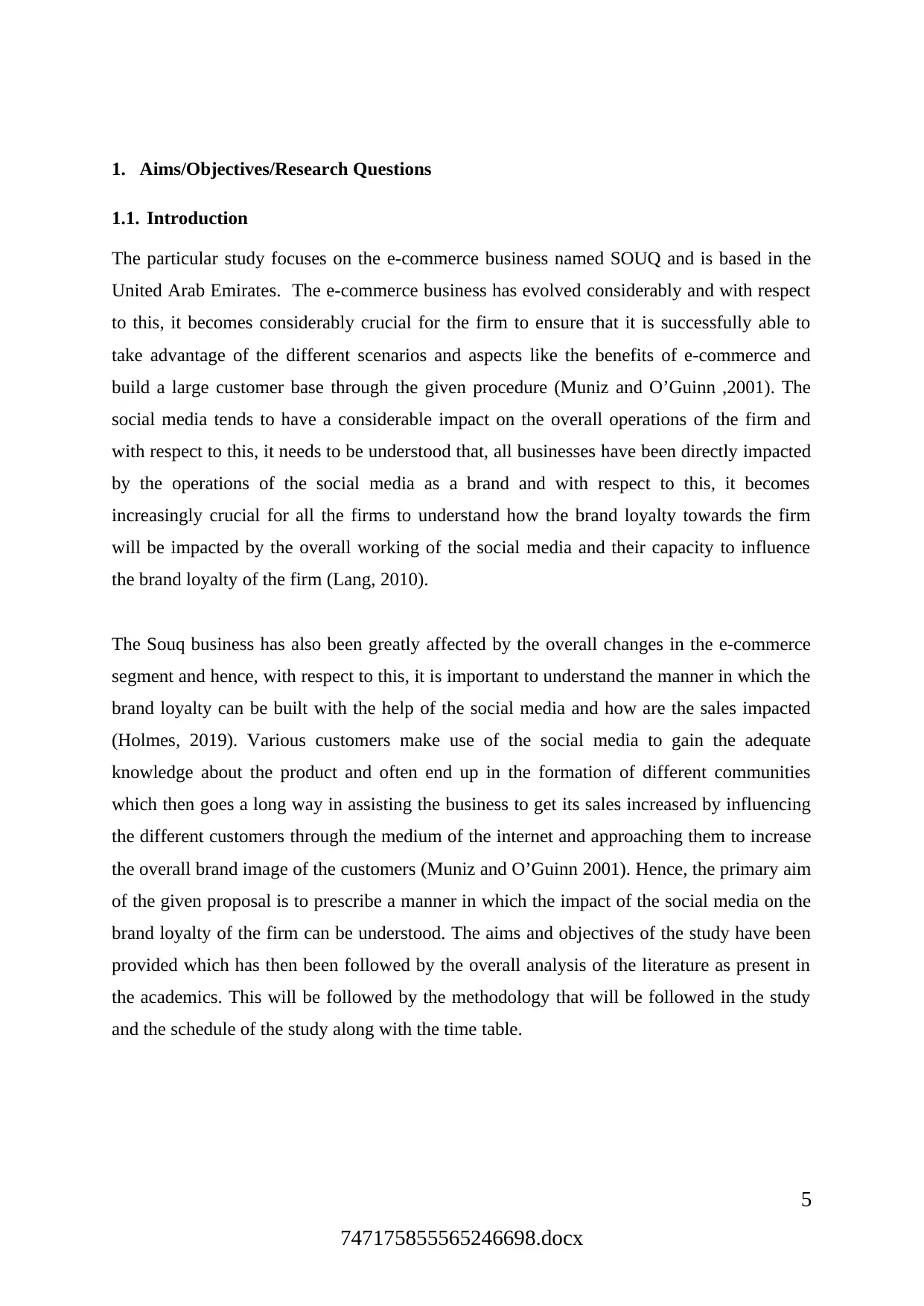
1. Aims/Objectives/Research Questions
1.1. Introduction
The particular study focuses on the e-commerce business named SOUQ and is based in the
United Arab Emirates. The e-commerce business has evolved considerably and with respect
to this, it becomes considerably crucial for the firm to ensure that it is successfully able to
take advantage of the different scenarios and aspects like the benefits of e-commerce and
build a large customer base through the given procedure (Muniz and O’Guinn ,2001). The
social media tends to have a considerable impact on the overall operations of the firm and
with respect to this, it needs to be understood that, all businesses have been directly impacted
by the operations of the social media as a brand and with respect to this, it becomes
increasingly crucial for all the firms to understand how the brand loyalty towards the firm
will be impacted by the overall working of the social media and their capacity to influence
the brand loyalty of the firm (Lang, 2010).
The Souq business has also been greatly affected by the overall changes in the e-commerce
segment and hence, with respect to this, it is important to understand the manner in which the
brand loyalty can be built with the help of the social media and how are the sales impacted
(Holmes, 2019). Various customers make use of the social media to gain the adequate
knowledge about the product and often end up in the formation of different communities
which then goes a long way in assisting the business to get its sales increased by influencing
the different customers through the medium of the internet and approaching them to increase
the overall brand image of the customers (Muniz and O’Guinn 2001). Hence, the primary aim
of the given proposal is to prescribe a manner in which the impact of the social media on the
brand loyalty of the firm can be understood. The aims and objectives of the study have been
provided which has then been followed by the overall analysis of the literature as present in
the academics. This will be followed by the methodology that will be followed in the study
and the schedule of the study along with the time table.
747175855565246698.docx
5
1.1. Introduction
The particular study focuses on the e-commerce business named SOUQ and is based in the
United Arab Emirates. The e-commerce business has evolved considerably and with respect
to this, it becomes considerably crucial for the firm to ensure that it is successfully able to
take advantage of the different scenarios and aspects like the benefits of e-commerce and
build a large customer base through the given procedure (Muniz and O’Guinn ,2001). The
social media tends to have a considerable impact on the overall operations of the firm and
with respect to this, it needs to be understood that, all businesses have been directly impacted
by the operations of the social media as a brand and with respect to this, it becomes
increasingly crucial for all the firms to understand how the brand loyalty towards the firm
will be impacted by the overall working of the social media and their capacity to influence
the brand loyalty of the firm (Lang, 2010).
The Souq business has also been greatly affected by the overall changes in the e-commerce
segment and hence, with respect to this, it is important to understand the manner in which the
brand loyalty can be built with the help of the social media and how are the sales impacted
(Holmes, 2019). Various customers make use of the social media to gain the adequate
knowledge about the product and often end up in the formation of different communities
which then goes a long way in assisting the business to get its sales increased by influencing
the different customers through the medium of the internet and approaching them to increase
the overall brand image of the customers (Muniz and O’Guinn 2001). Hence, the primary aim
of the given proposal is to prescribe a manner in which the impact of the social media on the
brand loyalty of the firm can be understood. The aims and objectives of the study have been
provided which has then been followed by the overall analysis of the literature as present in
the academics. This will be followed by the methodology that will be followed in the study
and the schedule of the study along with the time table.
747175855565246698.docx
5
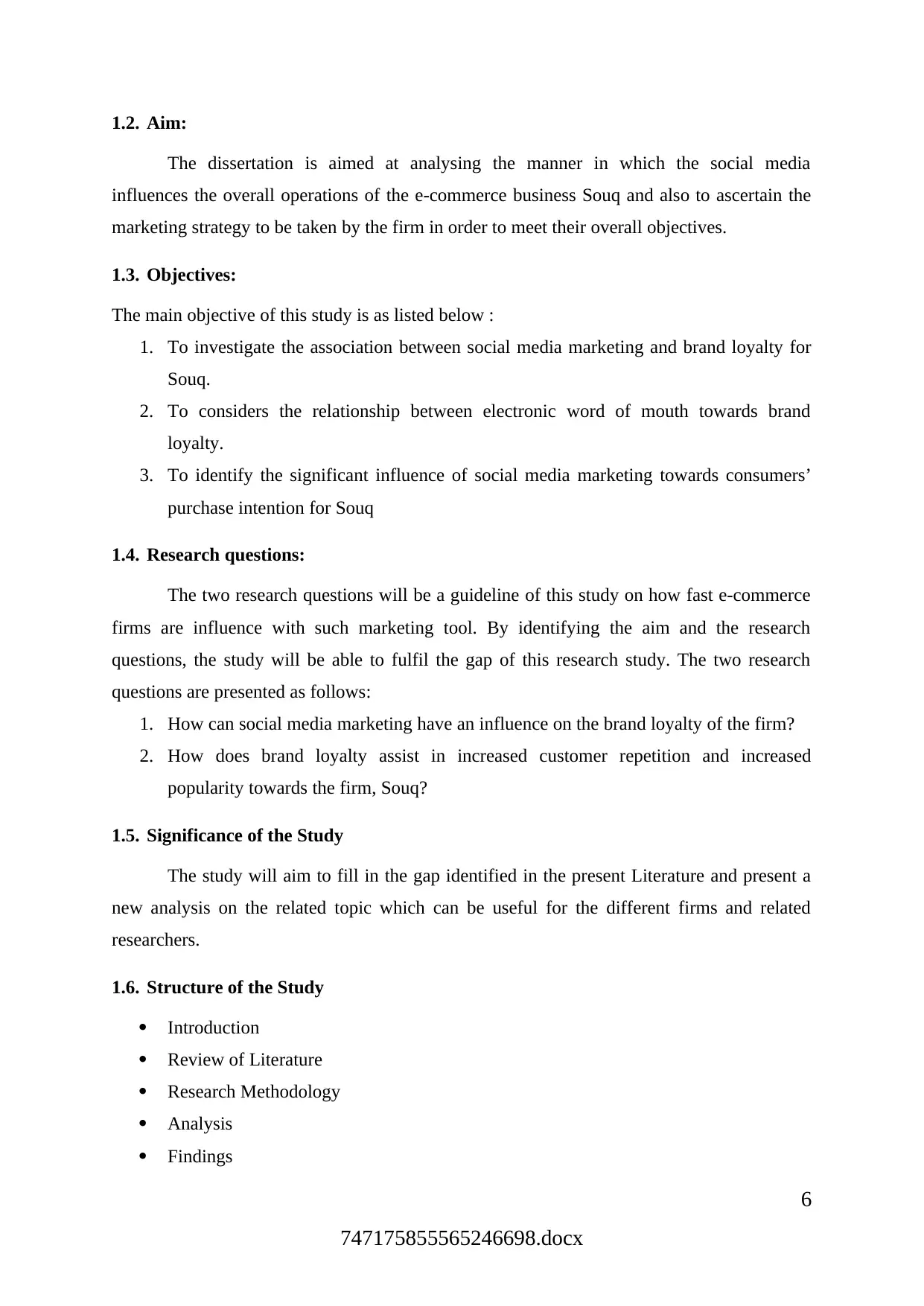
1.2. Aim:
The dissertation is aimed at analysing the manner in which the social media
influences the overall operations of the e-commerce business Souq and also to ascertain the
marketing strategy to be taken by the firm in order to meet their overall objectives.
1.3. Objectives:
The main objective of this study is as listed below :
1. To investigate the association between social media marketing and brand loyalty for
Souq.
2. To considers the relationship between electronic word of mouth towards brand
loyalty.
3. To identify the significant influence of social media marketing towards consumers’
purchase intention for Souq
1.4. Research questions:
The two research questions will be a guideline of this study on how fast e-commerce
firms are influence with such marketing tool. By identifying the aim and the research
questions, the study will be able to fulfil the gap of this research study. The two research
questions are presented as follows:
1. How can social media marketing have an influence on the brand loyalty of the firm?
2. How does brand loyalty assist in increased customer repetition and increased
popularity towards the firm, Souq?
1.5. Significance of the Study
The study will aim to fill in the gap identified in the present Literature and present a
new analysis on the related topic which can be useful for the different firms and related
researchers.
1.6. Structure of the Study
Introduction
Review of Literature
Research Methodology
Analysis
Findings
747175855565246698.docx
6
The dissertation is aimed at analysing the manner in which the social media
influences the overall operations of the e-commerce business Souq and also to ascertain the
marketing strategy to be taken by the firm in order to meet their overall objectives.
1.3. Objectives:
The main objective of this study is as listed below :
1. To investigate the association between social media marketing and brand loyalty for
Souq.
2. To considers the relationship between electronic word of mouth towards brand
loyalty.
3. To identify the significant influence of social media marketing towards consumers’
purchase intention for Souq
1.4. Research questions:
The two research questions will be a guideline of this study on how fast e-commerce
firms are influence with such marketing tool. By identifying the aim and the research
questions, the study will be able to fulfil the gap of this research study. The two research
questions are presented as follows:
1. How can social media marketing have an influence on the brand loyalty of the firm?
2. How does brand loyalty assist in increased customer repetition and increased
popularity towards the firm, Souq?
1.5. Significance of the Study
The study will aim to fill in the gap identified in the present Literature and present a
new analysis on the related topic which can be useful for the different firms and related
researchers.
1.6. Structure of the Study
Introduction
Review of Literature
Research Methodology
Analysis
Findings
747175855565246698.docx
6
⊘ This is a preview!⊘
Do you want full access?
Subscribe today to unlock all pages.

Trusted by 1+ million students worldwide
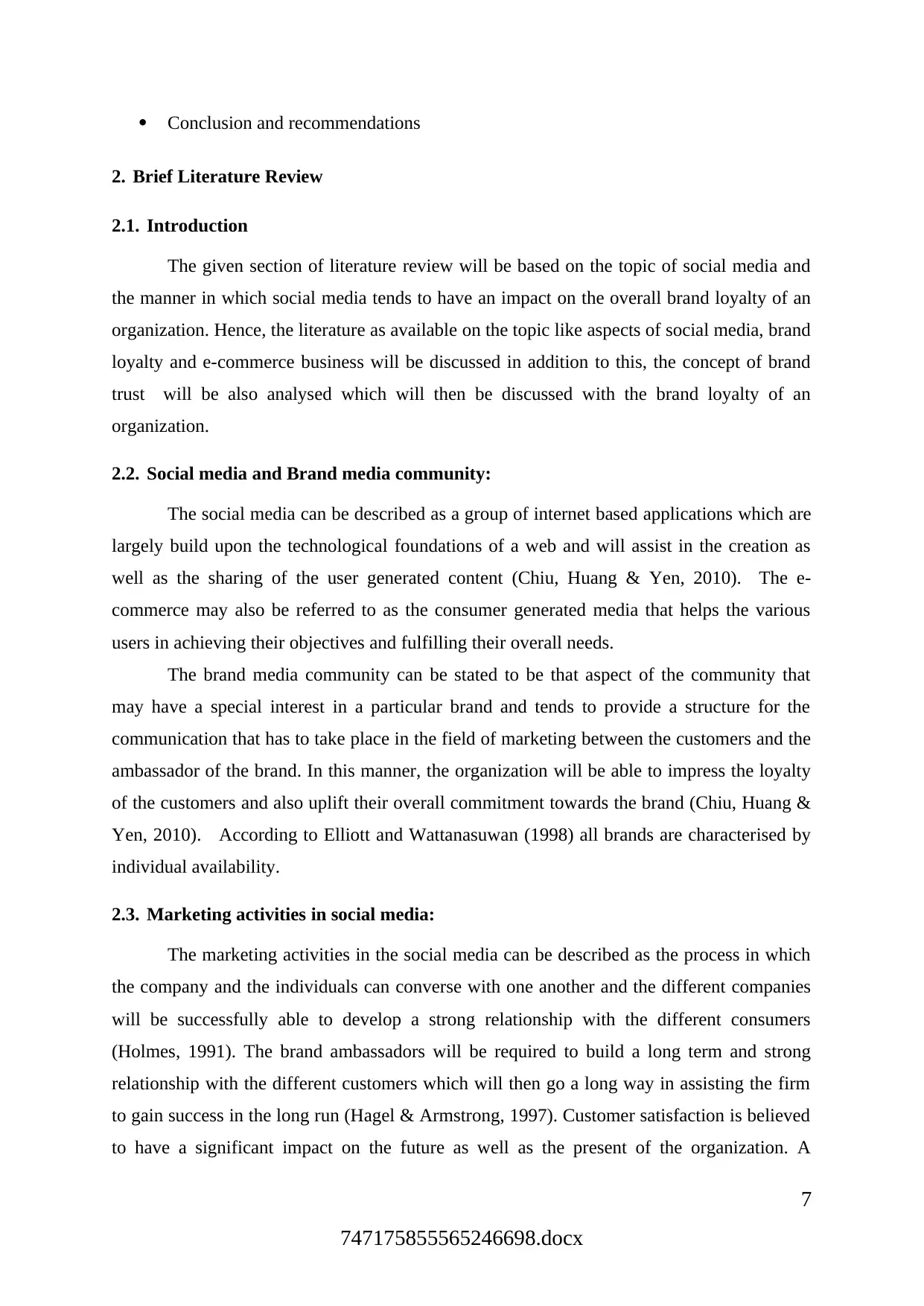
Conclusion and recommendations
2. Brief Literature Review
2.1. Introduction
The given section of literature review will be based on the topic of social media and
the manner in which social media tends to have an impact on the overall brand loyalty of an
organization. Hence, the literature as available on the topic like aspects of social media, brand
loyalty and e-commerce business will be discussed in addition to this, the concept of brand
trust will be also analysed which will then be discussed with the brand loyalty of an
organization.
2.2. Social media and Brand media community:
The social media can be described as a group of internet based applications which are
largely build upon the technological foundations of a web and will assist in the creation as
well as the sharing of the user generated content (Chiu, Huang & Yen, 2010). The e-
commerce may also be referred to as the consumer generated media that helps the various
users in achieving their objectives and fulfilling their overall needs.
The brand media community can be stated to be that aspect of the community that
may have a special interest in a particular brand and tends to provide a structure for the
communication that has to take place in the field of marketing between the customers and the
ambassador of the brand. In this manner, the organization will be able to impress the loyalty
of the customers and also uplift their overall commitment towards the brand (Chiu, Huang &
Yen, 2010). According to Elliott and Wattanasuwan (1998) all brands are characterised by
individual availability.
2.3. Marketing activities in social media:
The marketing activities in the social media can be described as the process in which
the company and the individuals can converse with one another and the different companies
will be successfully able to develop a strong relationship with the different consumers
(Holmes, 1991). The brand ambassadors will be required to build a long term and strong
relationship with the different customers which will then go a long way in assisting the firm
to gain success in the long run (Hagel & Armstrong, 1997). Customer satisfaction is believed
to have a significant impact on the future as well as the present of the organization. A
747175855565246698.docx
7
2. Brief Literature Review
2.1. Introduction
The given section of literature review will be based on the topic of social media and
the manner in which social media tends to have an impact on the overall brand loyalty of an
organization. Hence, the literature as available on the topic like aspects of social media, brand
loyalty and e-commerce business will be discussed in addition to this, the concept of brand
trust will be also analysed which will then be discussed with the brand loyalty of an
organization.
2.2. Social media and Brand media community:
The social media can be described as a group of internet based applications which are
largely build upon the technological foundations of a web and will assist in the creation as
well as the sharing of the user generated content (Chiu, Huang & Yen, 2010). The e-
commerce may also be referred to as the consumer generated media that helps the various
users in achieving their objectives and fulfilling their overall needs.
The brand media community can be stated to be that aspect of the community that
may have a special interest in a particular brand and tends to provide a structure for the
communication that has to take place in the field of marketing between the customers and the
ambassador of the brand. In this manner, the organization will be able to impress the loyalty
of the customers and also uplift their overall commitment towards the brand (Chiu, Huang &
Yen, 2010). According to Elliott and Wattanasuwan (1998) all brands are characterised by
individual availability.
2.3. Marketing activities in social media:
The marketing activities in the social media can be described as the process in which
the company and the individuals can converse with one another and the different companies
will be successfully able to develop a strong relationship with the different consumers
(Holmes, 1991). The brand ambassadors will be required to build a long term and strong
relationship with the different customers which will then go a long way in assisting the firm
to gain success in the long run (Hagel & Armstrong, 1997). Customer satisfaction is believed
to have a significant impact on the future as well as the present of the organization. A
747175855565246698.docx
7
Paraphrase This Document
Need a fresh take? Get an instant paraphrase of this document with our AI Paraphraser
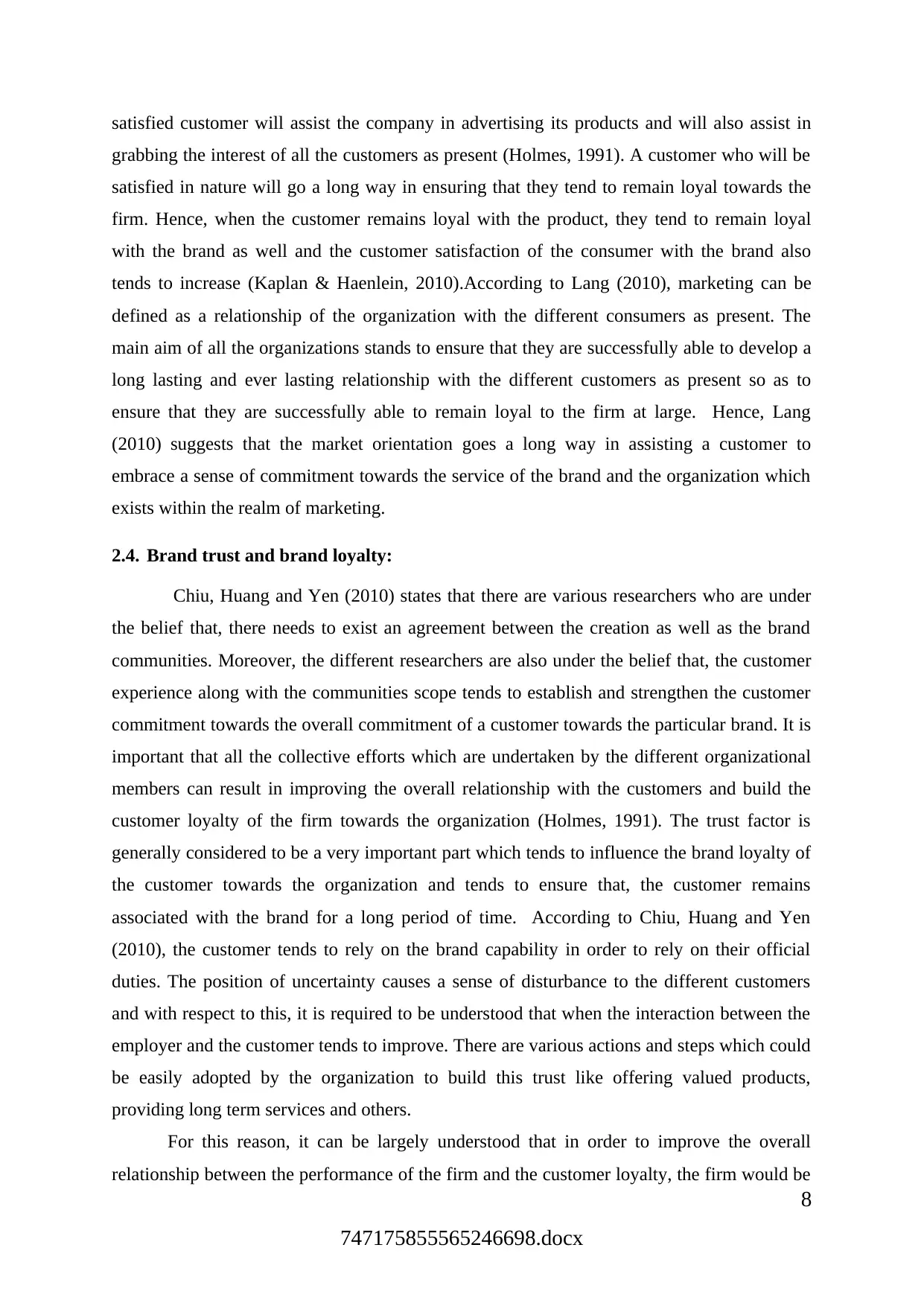
satisfied customer will assist the company in advertising its products and will also assist in
grabbing the interest of all the customers as present (Holmes, 1991). A customer who will be
satisfied in nature will go a long way in ensuring that they tend to remain loyal towards the
firm. Hence, when the customer remains loyal with the product, they tend to remain loyal
with the brand as well and the customer satisfaction of the consumer with the brand also
tends to increase (Kaplan & Haenlein, 2010).According to Lang (2010), marketing can be
defined as a relationship of the organization with the different consumers as present. The
main aim of all the organizations stands to ensure that they are successfully able to develop a
long lasting and ever lasting relationship with the different customers as present so as to
ensure that they are successfully able to remain loyal to the firm at large. Hence, Lang
(2010) suggests that the market orientation goes a long way in assisting a customer to
embrace a sense of commitment towards the service of the brand and the organization which
exists within the realm of marketing.
2.4. Brand trust and brand loyalty:
Chiu, Huang and Yen (2010) states that there are various researchers who are under
the belief that, there needs to exist an agreement between the creation as well as the brand
communities. Moreover, the different researchers are also under the belief that, the customer
experience along with the communities scope tends to establish and strengthen the customer
commitment towards the overall commitment of a customer towards the particular brand. It is
important that all the collective efforts which are undertaken by the different organizational
members can result in improving the overall relationship with the customers and build the
customer loyalty of the firm towards the organization (Holmes, 1991). The trust factor is
generally considered to be a very important part which tends to influence the brand loyalty of
the customer towards the organization and tends to ensure that, the customer remains
associated with the brand for a long period of time. According to Chiu, Huang and Yen
(2010), the customer tends to rely on the brand capability in order to rely on their official
duties. The position of uncertainty causes a sense of disturbance to the different customers
and with respect to this, it is required to be understood that when the interaction between the
employer and the customer tends to improve. There are various actions and steps which could
be easily adopted by the organization to build this trust like offering valued products,
providing long term services and others.
For this reason, it can be largely understood that in order to improve the overall
relationship between the performance of the firm and the customer loyalty, the firm would be
747175855565246698.docx
8
grabbing the interest of all the customers as present (Holmes, 1991). A customer who will be
satisfied in nature will go a long way in ensuring that they tend to remain loyal towards the
firm. Hence, when the customer remains loyal with the product, they tend to remain loyal
with the brand as well and the customer satisfaction of the consumer with the brand also
tends to increase (Kaplan & Haenlein, 2010).According to Lang (2010), marketing can be
defined as a relationship of the organization with the different consumers as present. The
main aim of all the organizations stands to ensure that they are successfully able to develop a
long lasting and ever lasting relationship with the different customers as present so as to
ensure that they are successfully able to remain loyal to the firm at large. Hence, Lang
(2010) suggests that the market orientation goes a long way in assisting a customer to
embrace a sense of commitment towards the service of the brand and the organization which
exists within the realm of marketing.
2.4. Brand trust and brand loyalty:
Chiu, Huang and Yen (2010) states that there are various researchers who are under
the belief that, there needs to exist an agreement between the creation as well as the brand
communities. Moreover, the different researchers are also under the belief that, the customer
experience along with the communities scope tends to establish and strengthen the customer
commitment towards the overall commitment of a customer towards the particular brand. It is
important that all the collective efforts which are undertaken by the different organizational
members can result in improving the overall relationship with the customers and build the
customer loyalty of the firm towards the organization (Holmes, 1991). The trust factor is
generally considered to be a very important part which tends to influence the brand loyalty of
the customer towards the organization and tends to ensure that, the customer remains
associated with the brand for a long period of time. According to Chiu, Huang and Yen
(2010), the customer tends to rely on the brand capability in order to rely on their official
duties. The position of uncertainty causes a sense of disturbance to the different customers
and with respect to this, it is required to be understood that when the interaction between the
employer and the customer tends to improve. There are various actions and steps which could
be easily adopted by the organization to build this trust like offering valued products,
providing long term services and others.
For this reason, it can be largely understood that in order to improve the overall
relationship between the performance of the firm and the customer loyalty, the firm would be
747175855565246698.docx
8
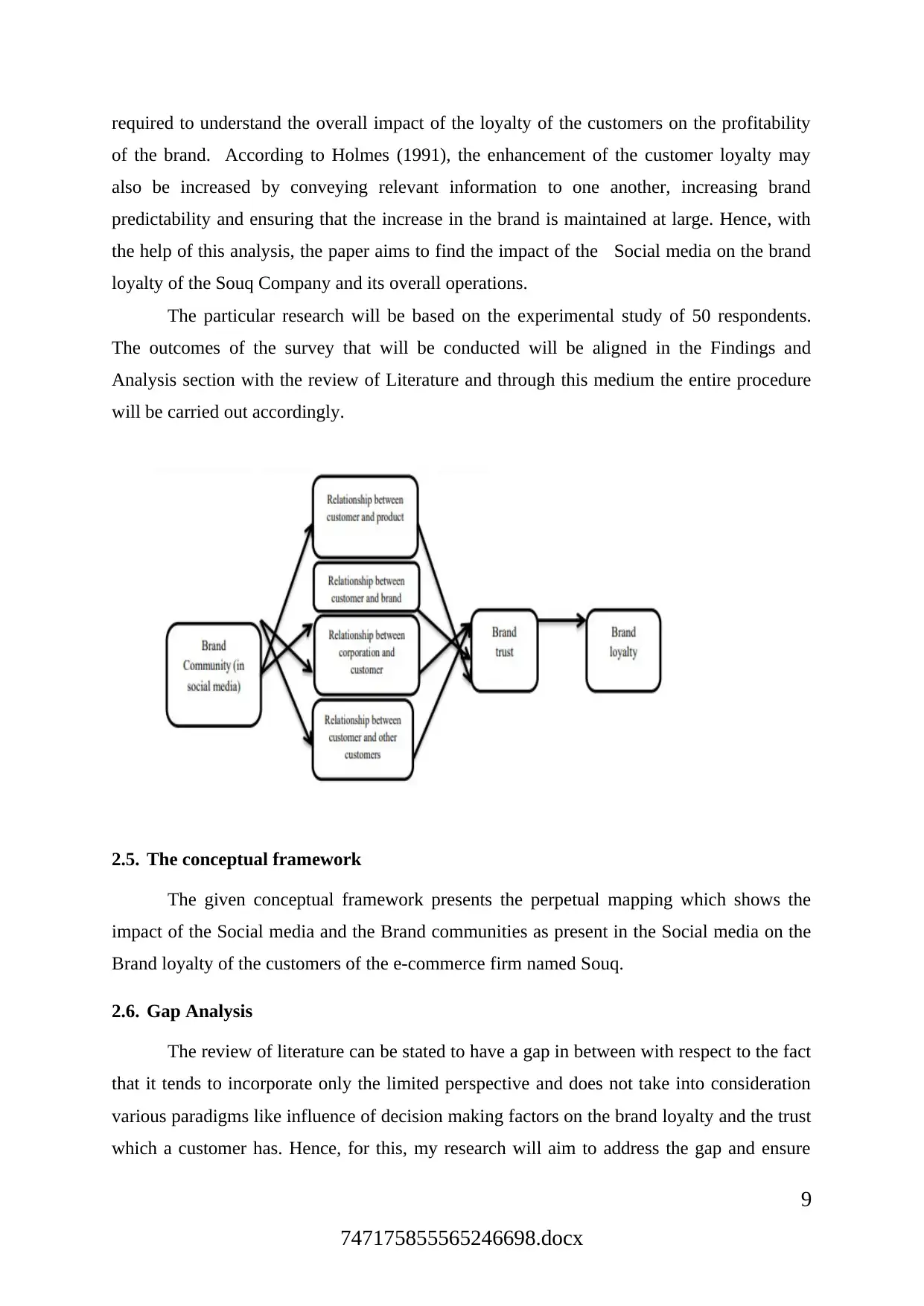
required to understand the overall impact of the loyalty of the customers on the profitability
of the brand. According to Holmes (1991), the enhancement of the customer loyalty may
also be increased by conveying relevant information to one another, increasing brand
predictability and ensuring that the increase in the brand is maintained at large. Hence, with
the help of this analysis, the paper aims to find the impact of the Social media on the brand
loyalty of the Souq Company and its overall operations.
The particular research will be based on the experimental study of 50 respondents.
The outcomes of the survey that will be conducted will be aligned in the Findings and
Analysis section with the review of Literature and through this medium the entire procedure
will be carried out accordingly.
2.5. The conceptual framework
The given conceptual framework presents the perpetual mapping which shows the
impact of the Social media and the Brand communities as present in the Social media on the
Brand loyalty of the customers of the e-commerce firm named Souq.
2.6. Gap Analysis
The review of literature can be stated to have a gap in between with respect to the fact
that it tends to incorporate only the limited perspective and does not take into consideration
various paradigms like influence of decision making factors on the brand loyalty and the trust
which a customer has. Hence, for this, my research will aim to address the gap and ensure
747175855565246698.docx
9
of the brand. According to Holmes (1991), the enhancement of the customer loyalty may
also be increased by conveying relevant information to one another, increasing brand
predictability and ensuring that the increase in the brand is maintained at large. Hence, with
the help of this analysis, the paper aims to find the impact of the Social media on the brand
loyalty of the Souq Company and its overall operations.
The particular research will be based on the experimental study of 50 respondents.
The outcomes of the survey that will be conducted will be aligned in the Findings and
Analysis section with the review of Literature and through this medium the entire procedure
will be carried out accordingly.
2.5. The conceptual framework
The given conceptual framework presents the perpetual mapping which shows the
impact of the Social media and the Brand communities as present in the Social media on the
Brand loyalty of the customers of the e-commerce firm named Souq.
2.6. Gap Analysis
The review of literature can be stated to have a gap in between with respect to the fact
that it tends to incorporate only the limited perspective and does not take into consideration
various paradigms like influence of decision making factors on the brand loyalty and the trust
which a customer has. Hence, for this, my research will aim to address the gap and ensure
747175855565246698.docx
9
⊘ This is a preview!⊘
Do you want full access?
Subscribe today to unlock all pages.

Trusted by 1+ million students worldwide
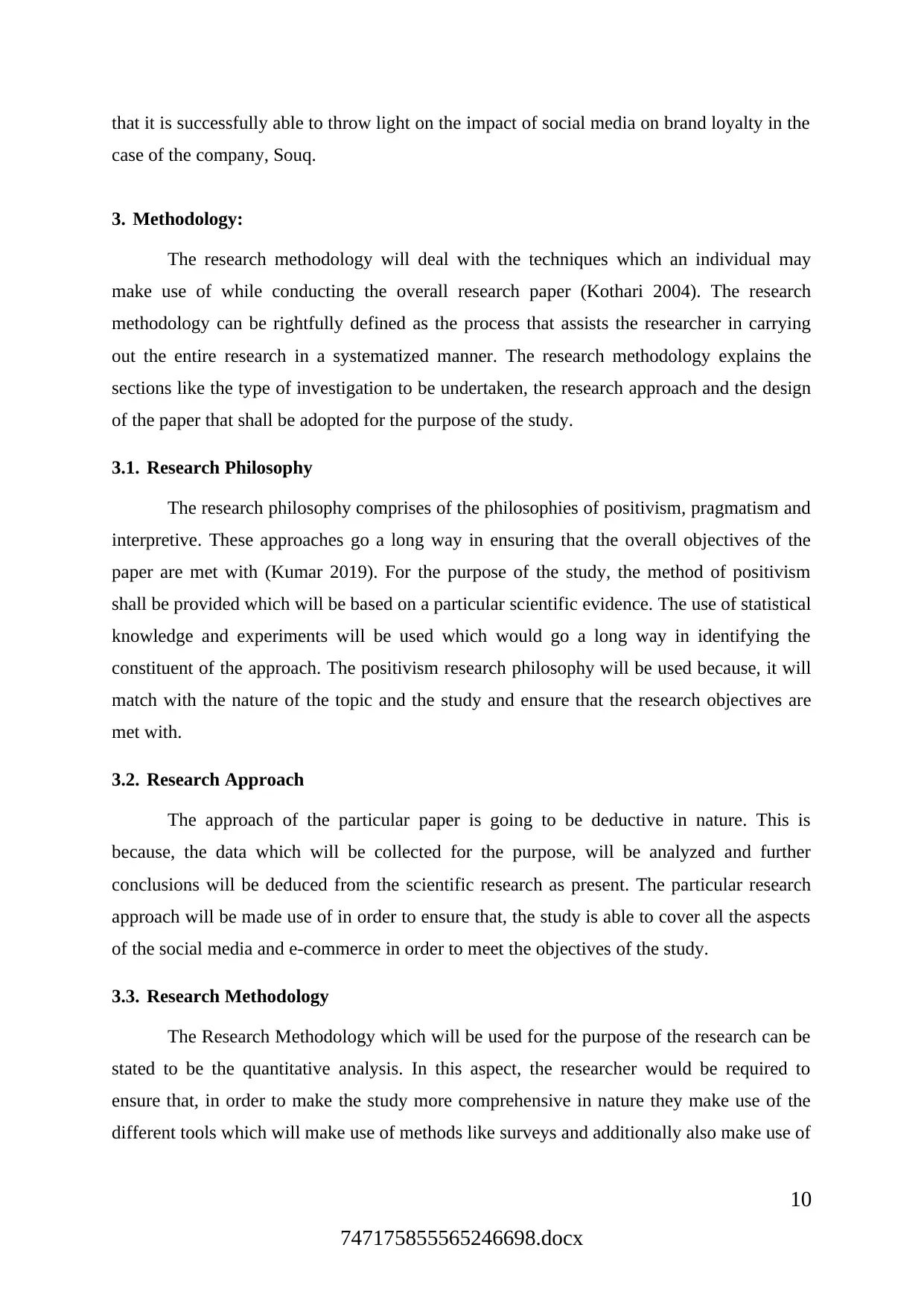
that it is successfully able to throw light on the impact of social media on brand loyalty in the
case of the company, Souq.
3. Methodology:
The research methodology will deal with the techniques which an individual may
make use of while conducting the overall research paper (Kothari 2004). The research
methodology can be rightfully defined as the process that assists the researcher in carrying
out the entire research in a systematized manner. The research methodology explains the
sections like the type of investigation to be undertaken, the research approach and the design
of the paper that shall be adopted for the purpose of the study.
3.1. Research Philosophy
The research philosophy comprises of the philosophies of positivism, pragmatism and
interpretive. These approaches go a long way in ensuring that the overall objectives of the
paper are met with (Kumar 2019). For the purpose of the study, the method of positivism
shall be provided which will be based on a particular scientific evidence. The use of statistical
knowledge and experiments will be used which would go a long way in identifying the
constituent of the approach. The positivism research philosophy will be used because, it will
match with the nature of the topic and the study and ensure that the research objectives are
met with.
3.2. Research Approach
The approach of the particular paper is going to be deductive in nature. This is
because, the data which will be collected for the purpose, will be analyzed and further
conclusions will be deduced from the scientific research as present. The particular research
approach will be made use of in order to ensure that, the study is able to cover all the aspects
of the social media and e-commerce in order to meet the objectives of the study.
3.3. Research Methodology
The Research Methodology which will be used for the purpose of the research can be
stated to be the quantitative analysis. In this aspect, the researcher would be required to
ensure that, in order to make the study more comprehensive in nature they make use of the
different tools which will make use of methods like surveys and additionally also make use of
747175855565246698.docx
10
case of the company, Souq.
3. Methodology:
The research methodology will deal with the techniques which an individual may
make use of while conducting the overall research paper (Kothari 2004). The research
methodology can be rightfully defined as the process that assists the researcher in carrying
out the entire research in a systematized manner. The research methodology explains the
sections like the type of investigation to be undertaken, the research approach and the design
of the paper that shall be adopted for the purpose of the study.
3.1. Research Philosophy
The research philosophy comprises of the philosophies of positivism, pragmatism and
interpretive. These approaches go a long way in ensuring that the overall objectives of the
paper are met with (Kumar 2019). For the purpose of the study, the method of positivism
shall be provided which will be based on a particular scientific evidence. The use of statistical
knowledge and experiments will be used which would go a long way in identifying the
constituent of the approach. The positivism research philosophy will be used because, it will
match with the nature of the topic and the study and ensure that the research objectives are
met with.
3.2. Research Approach
The approach of the particular paper is going to be deductive in nature. This is
because, the data which will be collected for the purpose, will be analyzed and further
conclusions will be deduced from the scientific research as present. The particular research
approach will be made use of in order to ensure that, the study is able to cover all the aspects
of the social media and e-commerce in order to meet the objectives of the study.
3.3. Research Methodology
The Research Methodology which will be used for the purpose of the research can be
stated to be the quantitative analysis. In this aspect, the researcher would be required to
ensure that, in order to make the study more comprehensive in nature they make use of the
different tools which will make use of methods like surveys and additionally also make use of
747175855565246698.docx
10
Paraphrase This Document
Need a fresh take? Get an instant paraphrase of this document with our AI Paraphraser
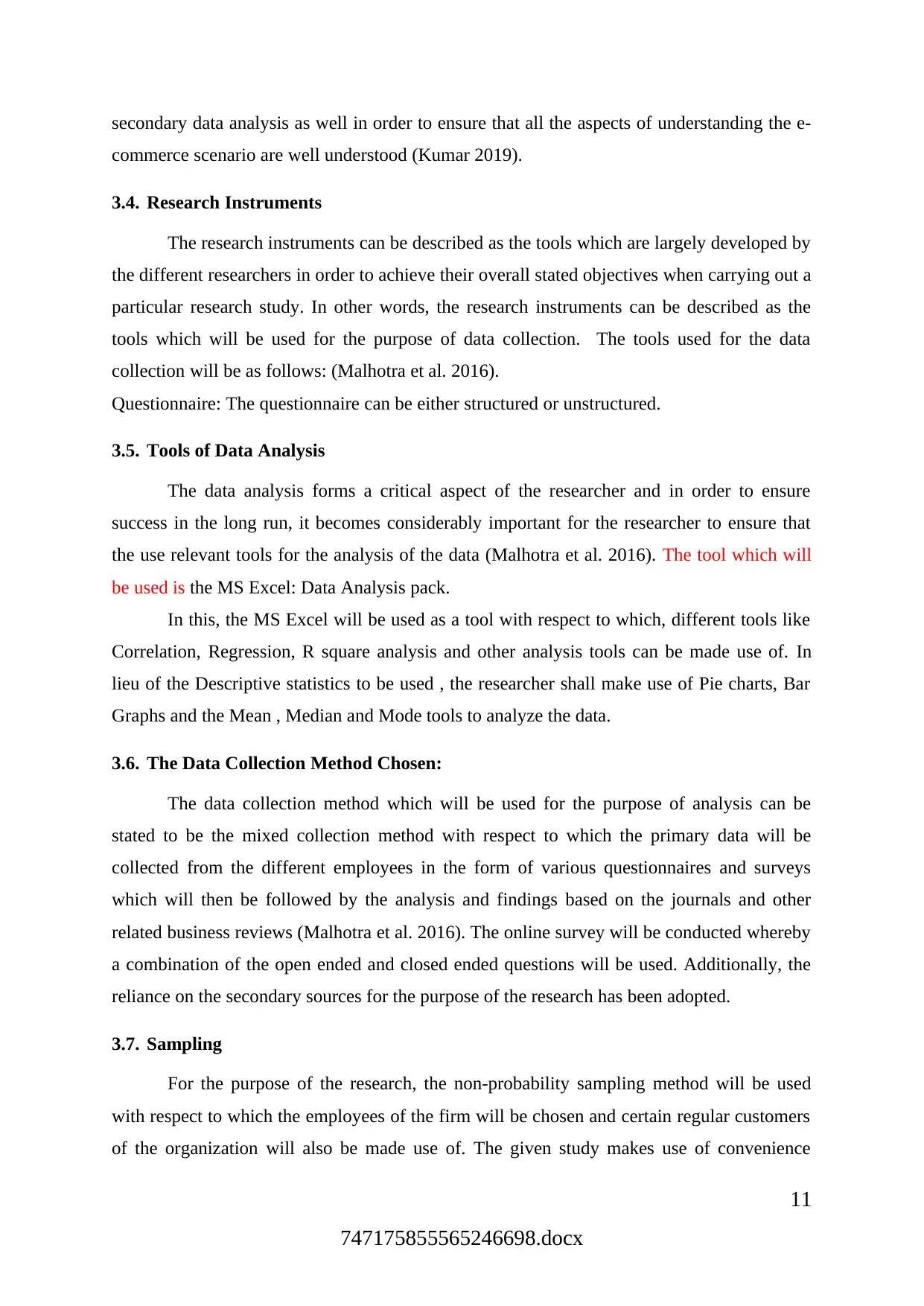
secondary data analysis as well in order to ensure that all the aspects of understanding the e-
commerce scenario are well understood (Kumar 2019).
3.4. Research Instruments
The research instruments can be described as the tools which are largely developed by
the different researchers in order to achieve their overall stated objectives when carrying out a
particular research study. In other words, the research instruments can be described as the
tools which will be used for the purpose of data collection. The tools used for the data
collection will be as follows: (Malhotra et al. 2016).
Questionnaire: The questionnaire can be either structured or unstructured.
3.5. Tools of Data Analysis
The data analysis forms a critical aspect of the researcher and in order to ensure
success in the long run, it becomes considerably important for the researcher to ensure that
the use relevant tools for the analysis of the data (Malhotra et al. 2016). The tool which will
be used is the MS Excel: Data Analysis pack.
In this, the MS Excel will be used as a tool with respect to which, different tools like
Correlation, Regression, R square analysis and other analysis tools can be made use of. In
lieu of the Descriptive statistics to be used , the researcher shall make use of Pie charts, Bar
Graphs and the Mean , Median and Mode tools to analyze the data.
3.6. The Data Collection Method Chosen:
The data collection method which will be used for the purpose of analysis can be
stated to be the mixed collection method with respect to which the primary data will be
collected from the different employees in the form of various questionnaires and surveys
which will then be followed by the analysis and findings based on the journals and other
related business reviews (Malhotra et al. 2016). The online survey will be conducted whereby
a combination of the open ended and closed ended questions will be used. Additionally, the
reliance on the secondary sources for the purpose of the research has been adopted.
3.7. Sampling
For the purpose of the research, the non-probability sampling method will be used
with respect to which the employees of the firm will be chosen and certain regular customers
of the organization will also be made use of. The given study makes use of convenience
747175855565246698.docx
11
commerce scenario are well understood (Kumar 2019).
3.4. Research Instruments
The research instruments can be described as the tools which are largely developed by
the different researchers in order to achieve their overall stated objectives when carrying out a
particular research study. In other words, the research instruments can be described as the
tools which will be used for the purpose of data collection. The tools used for the data
collection will be as follows: (Malhotra et al. 2016).
Questionnaire: The questionnaire can be either structured or unstructured.
3.5. Tools of Data Analysis
The data analysis forms a critical aspect of the researcher and in order to ensure
success in the long run, it becomes considerably important for the researcher to ensure that
the use relevant tools for the analysis of the data (Malhotra et al. 2016). The tool which will
be used is the MS Excel: Data Analysis pack.
In this, the MS Excel will be used as a tool with respect to which, different tools like
Correlation, Regression, R square analysis and other analysis tools can be made use of. In
lieu of the Descriptive statistics to be used , the researcher shall make use of Pie charts, Bar
Graphs and the Mean , Median and Mode tools to analyze the data.
3.6. The Data Collection Method Chosen:
The data collection method which will be used for the purpose of analysis can be
stated to be the mixed collection method with respect to which the primary data will be
collected from the different employees in the form of various questionnaires and surveys
which will then be followed by the analysis and findings based on the journals and other
related business reviews (Malhotra et al. 2016). The online survey will be conducted whereby
a combination of the open ended and closed ended questions will be used. Additionally, the
reliance on the secondary sources for the purpose of the research has been adopted.
3.7. Sampling
For the purpose of the research, the non-probability sampling method will be used
with respect to which the employees of the firm will be chosen and certain regular customers
of the organization will also be made use of. The given study makes use of convenience
747175855565246698.docx
11
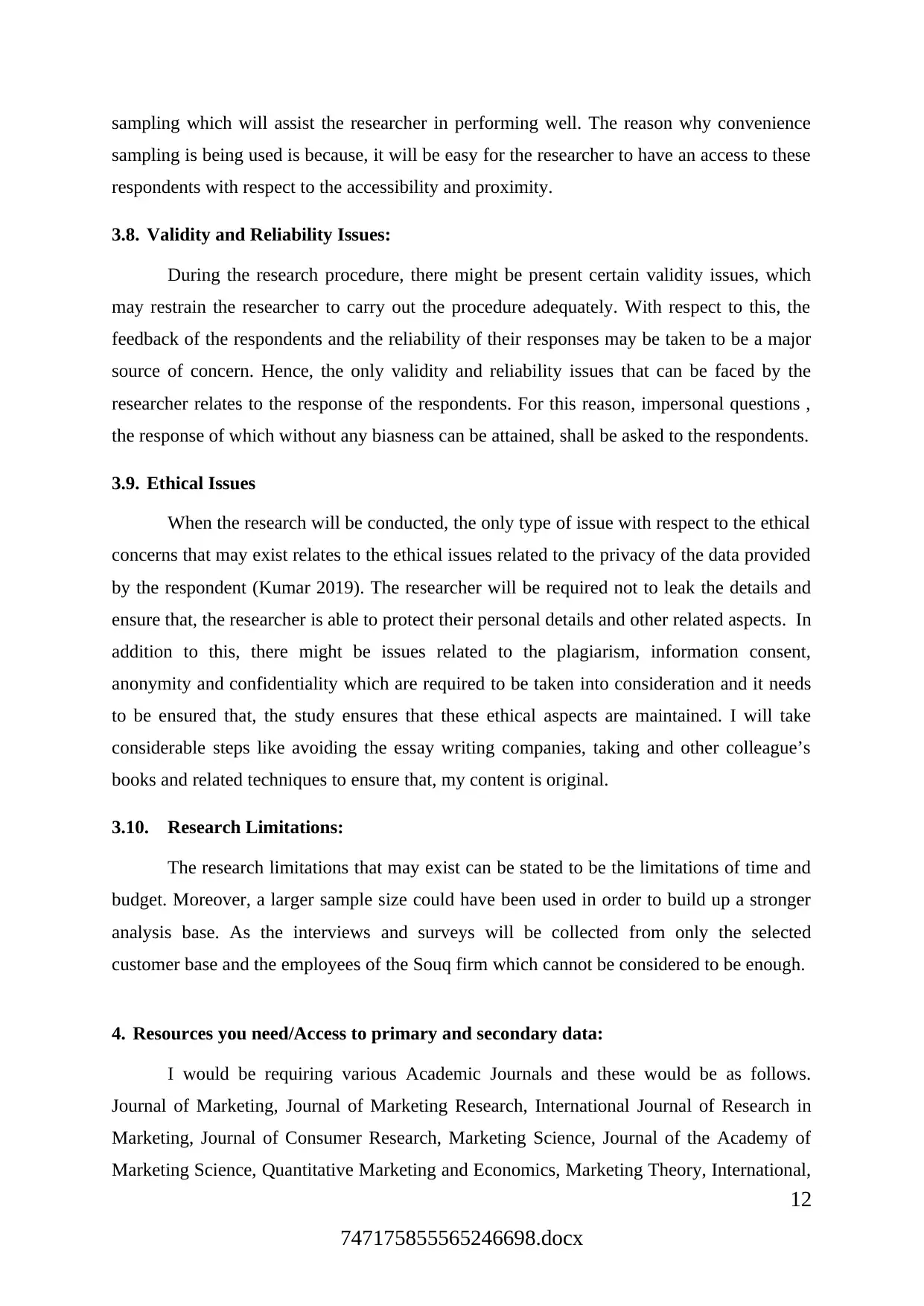
sampling which will assist the researcher in performing well. The reason why convenience
sampling is being used is because, it will be easy for the researcher to have an access to these
respondents with respect to the accessibility and proximity.
3.8. Validity and Reliability Issues:
During the research procedure, there might be present certain validity issues, which
may restrain the researcher to carry out the procedure adequately. With respect to this, the
feedback of the respondents and the reliability of their responses may be taken to be a major
source of concern. Hence, the only validity and reliability issues that can be faced by the
researcher relates to the response of the respondents. For this reason, impersonal questions ,
the response of which without any biasness can be attained, shall be asked to the respondents.
3.9. Ethical Issues
When the research will be conducted, the only type of issue with respect to the ethical
concerns that may exist relates to the ethical issues related to the privacy of the data provided
by the respondent (Kumar 2019). The researcher will be required not to leak the details and
ensure that, the researcher is able to protect their personal details and other related aspects. In
addition to this, there might be issues related to the plagiarism, information consent,
anonymity and confidentiality which are required to be taken into consideration and it needs
to be ensured that, the study ensures that these ethical aspects are maintained. I will take
considerable steps like avoiding the essay writing companies, taking and other colleague’s
books and related techniques to ensure that, my content is original.
3.10. Research Limitations:
The research limitations that may exist can be stated to be the limitations of time and
budget. Moreover, a larger sample size could have been used in order to build up a stronger
analysis base. As the interviews and surveys will be collected from only the selected
customer base and the employees of the Souq firm which cannot be considered to be enough.
4. Resources you need/Access to primary and secondary data:
I would be requiring various Academic Journals and these would be as follows.
Journal of Marketing, Journal of Marketing Research, International Journal of Research in
Marketing, Journal of Consumer Research, Marketing Science, Journal of the Academy of
Marketing Science, Quantitative Marketing and Economics, Marketing Theory, International,
747175855565246698.docx
12
sampling is being used is because, it will be easy for the researcher to have an access to these
respondents with respect to the accessibility and proximity.
3.8. Validity and Reliability Issues:
During the research procedure, there might be present certain validity issues, which
may restrain the researcher to carry out the procedure adequately. With respect to this, the
feedback of the respondents and the reliability of their responses may be taken to be a major
source of concern. Hence, the only validity and reliability issues that can be faced by the
researcher relates to the response of the respondents. For this reason, impersonal questions ,
the response of which without any biasness can be attained, shall be asked to the respondents.
3.9. Ethical Issues
When the research will be conducted, the only type of issue with respect to the ethical
concerns that may exist relates to the ethical issues related to the privacy of the data provided
by the respondent (Kumar 2019). The researcher will be required not to leak the details and
ensure that, the researcher is able to protect their personal details and other related aspects. In
addition to this, there might be issues related to the plagiarism, information consent,
anonymity and confidentiality which are required to be taken into consideration and it needs
to be ensured that, the study ensures that these ethical aspects are maintained. I will take
considerable steps like avoiding the essay writing companies, taking and other colleague’s
books and related techniques to ensure that, my content is original.
3.10. Research Limitations:
The research limitations that may exist can be stated to be the limitations of time and
budget. Moreover, a larger sample size could have been used in order to build up a stronger
analysis base. As the interviews and surveys will be collected from only the selected
customer base and the employees of the Souq firm which cannot be considered to be enough.
4. Resources you need/Access to primary and secondary data:
I would be requiring various Academic Journals and these would be as follows.
Journal of Marketing, Journal of Marketing Research, International Journal of Research in
Marketing, Journal of Consumer Research, Marketing Science, Journal of the Academy of
Marketing Science, Quantitative Marketing and Economics, Marketing Theory, International,
747175855565246698.docx
12
⊘ This is a preview!⊘
Do you want full access?
Subscribe today to unlock all pages.

Trusted by 1+ million students worldwide
1 out of 34
Related Documents
Your All-in-One AI-Powered Toolkit for Academic Success.
+13062052269
info@desklib.com
Available 24*7 on WhatsApp / Email
![[object Object]](/_next/static/media/star-bottom.7253800d.svg)
Unlock your academic potential
Copyright © 2020–2025 A2Z Services. All Rights Reserved. Developed and managed by ZUCOL.





